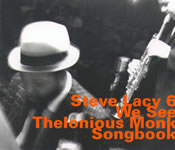|
|
 |
Dusted Reviews
Artist: Steve Lacy 6 Album: We See Label: Hat Hut Review date: May. 27, 2003 |

|
|
|
 |
More Monk
Steve Lacy and Thelonious Monk go way back – Lacy played with Monk in 1960, then formed a Monk tribute group with Roswell Rudd, Henry Grimes and Denis Charles shortly thereafter. That group can be heard playing Monk tunes on the recently reissued School Days, from 1963. Throughout Lacy’s career, which has ranged from dixieland to bop to seriously out-there improv, he has repeatedly returned to Monk’s music.
To this reviewer (who admires bop, but admittedly doesn’t listen to it regularly), many of Monk’s recordings from the late 1940s and early 1950s feel like Monk is embracing bop while simultaneously running circles around it. Monk stayed in touch with bop’s harmonic and rhythmic conventions (though he himself played no small role in creating those conventions) while pushing them just a little further than they usually go. His harmonies were a little more dissonant and his rhythms were a bit trickier than they might normally be in the hands of a lesser musician.
We See, a reissue of a 1992 set, shows that Lacy understands that Monk’s musical eccentricities mattered – whereas many young players want to airbrush Monk’s compositions or otherwise turn them into well-oiled machines, Lacy would rather celebrate both their idiosyncrasies and their more traditional elements. Lacy is joined here by three regular bandmates (alto and soprano saxophonist Steve Potts, bassist Jean-Jacques Avenel and drummer John Betsch) as well as trumpeter Hans Kennel and vibraphonist Sonhando Estwick. But the biggest reason for the off-kilter feel of We See is the absence of pianist Bobby Few, who collaborated with Lacy regularly throughout the 1980s and ’90s. In contrast with Few’s bluesy and often dense style, the musicians here mostly play lightly and stay in the background, leaving a huge amount of room for Lacy, whose high-pitched instrument and precise articulation – along with the wide berth he gets from the other musicians – make his playing sound more angular than it actually is. Lacy thus emphasizes the twists and turns in Monk’s compositions rather than the continuities.
Even when Lacy and company are playing more uptempo tunes, the record feels remarkably relaxed and self-assured, so much so that the busy theme on the album-ending Lacy composition “Hanky-Panky” feels almost hectic in comparison. Nothing on We See sounds particularly revolutionary, but it captures a quirkiness that nicely parallels that of Monk’s own playing.
By Charlie Wilmoth
|







